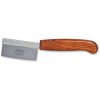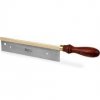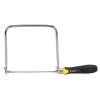Mark Hepburn
Artist & Chef
I'm wanting to make a parting tool that is thinner than my 1/16".
I'm taking a class with Steven Kennard this November, and we were talking at the symposium and he mentioned wanting one thinner than the 1/16 for his work. Makes sense to me but the tool doesn't seem to exist. Therefore I thought I'd try my hand at making a couple of them. Just a flat blade, full tang, a handle and bras rivets and Bob's your uncle. Hopefully.
Anyway, I've been looking all over the tubes of the interweb and can't find anything like a piece of flat M2 in that thickness. There's other stuff: D2, A2, and some other and I did find some CPM 3V in a .o48" blank.
Not being a metal guy I don't know if the CPM 3V would be a good candidate. Here's the information from Crucible Materials site:
CPM 3V is a high toughness, wear-resistant tool steel made by the Crucible Particle Metallurgy process. It is designed to provide maximum resistance to breakage and chipping in a high wear-resistance steel. It offers impact resistance greater than A2, D2, Cru-Wear, or CPM M4, approaching the levels provided by S7 and other shock resistant grades. CPM 3V is intended to be used at 58/60 HRC in applications where chronic breakage and chipping are encountered in other tool steels, but where the wear properties of a high alloy steel are required.
Nominal Composition
Carbon 0.80%
Chromium 7.50%
Vanadium 2.75%
Molybdenum 1.30%
Typical Applications
Stamping or Forming Tools Punches and Dies
Blanking Tools Fineblanking Tools
Industrial Knives and Slitters Shear Blades
Scrap Choppers Rolls
Plastic Injection and Extrusion Feedscrews
The wear and toughness properties of CPM 3V make it an excellent alternative to shock-resistant steels such as S7 or A9, where they typically wear out too quickly, but where grades such as A2, CruWear, or CPM M4 tend to fail by breaking or chipping. CPM 3V offers the highest impact toughness of any tool steel with this range of wear resistance.
So it seems to me that this might be a good way to go, but I'd appreciate any input from those of you with metallurgical expertise.
Thanks!
I'm taking a class with Steven Kennard this November, and we were talking at the symposium and he mentioned wanting one thinner than the 1/16 for his work. Makes sense to me but the tool doesn't seem to exist. Therefore I thought I'd try my hand at making a couple of them. Just a flat blade, full tang, a handle and bras rivets and Bob's your uncle. Hopefully.
Anyway, I've been looking all over the tubes of the interweb and can't find anything like a piece of flat M2 in that thickness. There's other stuff: D2, A2, and some other and I did find some CPM 3V in a .o48" blank.
Not being a metal guy I don't know if the CPM 3V would be a good candidate. Here's the information from Crucible Materials site:
CPM 3V is a high toughness, wear-resistant tool steel made by the Crucible Particle Metallurgy process. It is designed to provide maximum resistance to breakage and chipping in a high wear-resistance steel. It offers impact resistance greater than A2, D2, Cru-Wear, or CPM M4, approaching the levels provided by S7 and other shock resistant grades. CPM 3V is intended to be used at 58/60 HRC in applications where chronic breakage and chipping are encountered in other tool steels, but where the wear properties of a high alloy steel are required.
Nominal Composition
Carbon 0.80%
Chromium 7.50%
Vanadium 2.75%
Molybdenum 1.30%
Typical Applications
Stamping or Forming Tools Punches and Dies
Blanking Tools Fineblanking Tools
Industrial Knives and Slitters Shear Blades
Scrap Choppers Rolls
Plastic Injection and Extrusion Feedscrews
The wear and toughness properties of CPM 3V make it an excellent alternative to shock-resistant steels such as S7 or A9, where they typically wear out too quickly, but where grades such as A2, CruWear, or CPM M4 tend to fail by breaking or chipping. CPM 3V offers the highest impact toughness of any tool steel with this range of wear resistance.
So it seems to me that this might be a good way to go, but I'd appreciate any input from those of you with metallurgical expertise.
Thanks!




